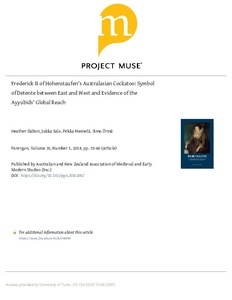Frederick II of Hohenstaufen's Australasian Cockatoo: Symbol of Detente between East and West and Evidence of the Ayyubids' Global Reach
Heather Dalton; Jukka Salo; Pekka Niemelä; Simo Örmä
Frederick II of Hohenstaufen's Australasian Cockatoo: Symbol of Detente between East and West and Evidence of the Ayyubids' Global Reach
Heather Dalton
Jukka Salo
Pekka Niemelä
Simo Örmä
AUSTRALIAN NZ ASSOC MEDIEVAL EARLY MODERN STUDIES
Julkaisun pysyvä osoite on:
https://urn.fi/URN:NBN:fi-fe2021042719796
https://urn.fi/URN:NBN:fi-fe2021042719796
Tiivistelmä
Frederick II of Sicily made contact with the Kurdish al-Malik Muhammad al-Kamil in 1217-a year before al-Malik became sultan of Egypt. The two rulers communicated regularly over the following twenty years, exchanging letters, books and rare and exotic animals. The focus of this article is the Sulphur-crested or Yellow-crested Cockatoo the sultan sent Frederick. A written description and four sketches of this parrot survive in a mid thirteenth-century manuscript in the Vatican Library. This article reviews these images, revealing that Australasian cockatoos were present in the Middle East in the medieval period and exploring how and why one reached Europe in the mid thirteenth century.
Kokoelmat
- Rinnakkaistallenteet [27094]
